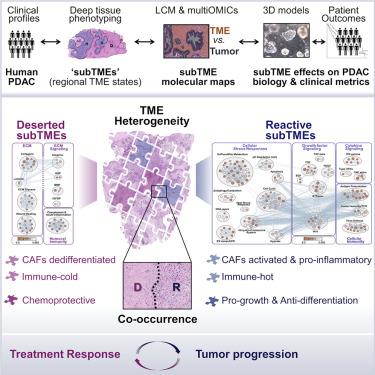Cell ( IF 45.5 ) Pub Date : 2021-10-12 , DOI: 10.1016/j.cell.2021.09.022 Barbara T Grünwald 1 , Antoine Devisme 2 , Geoffroy Andrieux 3 , Foram Vyas 4 , Kazeera Aliar 1 , Curtis W McCloskey 1 , Andrew Macklin 1 , Gun Ho Jang 5 , Robert Denroche 5 , Joan Miguel Romero 5 , Prashant Bavi 6 , Peter Bronsert 7 , Faiyaz Notta 8 , Grainne O'Kane 9 , Julie Wilson 5 , Jennifer Knox 9 , Laura Tamblyn 10 , Molly Udaskin 10 , Nikolina Radulovich 10 , Sandra E Fischer 11 , Melanie Boerries 3 , Steven Gallinger 12 , Thomas Kislinger 4 , Rama Khokha 4

|
Intratumoral heterogeneity is a critical frontier in understanding how the tumor microenvironment (TME) propels malignant progression. Here, we deconvolute the human pancreatic TME through large-scale integration of histology-guided regional multiOMICs with clinical data and patient-derived preclinical models. We discover “subTMEs,” histologically definable tissue states anchored in fibroblast plasticity, with regional relationships to tumor immunity, subtypes, differentiation, and treatment response. “Reactive” subTMEs rich in complex but functionally coordinated fibroblast communities were immune hot and inhabited by aggressive tumor cell phenotypes. The matrix-rich “deserted” subTMEs harbored fewer activated fibroblasts and tumor-suppressive features yet were markedly chemoprotective and enriched upon chemotherapy. SubTMEs originated in fibroblast differentiation trajectories, and transitory states were notable both in single-cell transcriptomics and in situ. The intratumoral co-occurrence of subTMEs produced patient-specific phenotypic and computationally predictable heterogeneity tightly linked to malignant biology. Therefore, heterogeneity within the plentiful, notorious pancreatic TME is not random but marks fundamental tissue organizational units.
中文翻译:

胰腺癌中空间受限的亚肿瘤微环境
肿瘤内异质性是了解肿瘤微环境 (TME) 如何推动恶性进展的关键前沿。在这里,我们通过将组织学引导的区域多组学与临床数据和患者衍生的临床前模型进行大规模整合,对人类胰腺 TME 进行反卷积。我们发现了“subTME”,即以成纤维细胞可塑性为基础的组织学上可定义的组织状态,与肿瘤免疫、亚型、分化和治疗反应具有区域关系。富含复杂但功能协调的成纤维细胞群落的“反应性”亚 TME 具有免疫热,并被侵袭性肿瘤细胞表型占据。富含基质的“废弃”亚TMEs具有较少的活化成纤维细胞和肿瘤抑制特征,但在化疗后具有显着的化学保护性和丰富性。原地。subTMEs 的肿瘤内同时出现产生了与恶性生物学密切相关的患者特异性表型和计算上可预测的异质性。因此,大量、臭名昭著的胰腺 TME 内的异质性不是随机的,而是标志着基本的组织组织单位。











































 京公网安备 11010802027423号
京公网安备 11010802027423号